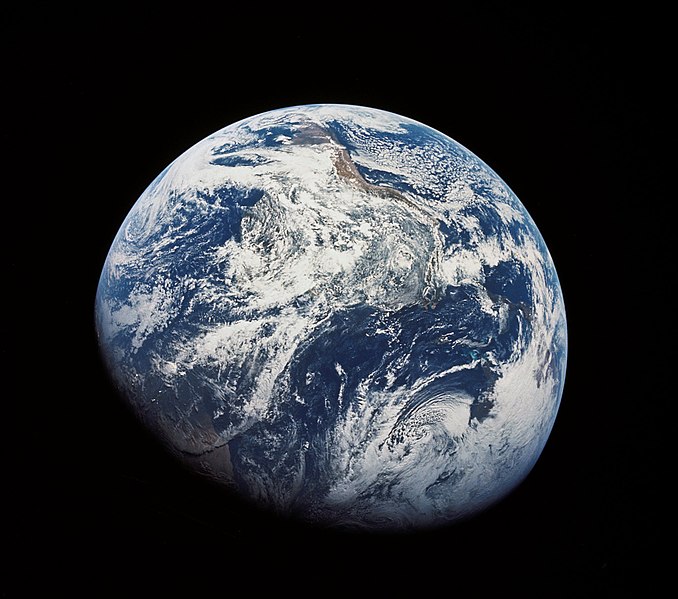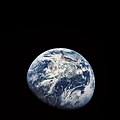پەڕگە:As08-16-2593.jpg

قەبارەی ئەم پێشبینینە: ٦٧٨ لە ٥٩٩ پیکسەڵ. ڕێزەلووشنەکانی تر: ٢٧٢ لە ٢٤٠ پیکسەڵ | ٥٤٣ لە ٤٨٠ پیکسەڵ | ٨٦٩ لە ٧٦٨ پیکسەڵ | ١٬١٥٩ لە ١٬٠٢٤ پیکسەڵ | ٢٬٠١٥ لە ١٬٧٨١ پیکسەڵ.
پەڕگەی سەرەکی (٢٬٠١٥ × ١٬٧٨١ پیکسڵ، قەبارەی پەڕگە: ٦٢١ کیلۆبایت، جۆری ئێم ئای ئێم ئی: image/jpeg)
مێژووی پەڕگە
کرتە بکە لەسەر یەکێک لە ڕێکەوت/کاتەکان بۆ بینینی پەڕگەکە بەو شێوەی لەو کاتەدا بووە.
| ڕێکەوت/کات | ھێما | ئەندازە | بەکارھێنەر | تێبینی | |
|---|---|---|---|---|---|
| هەنووکە | ١٧:١٩، ١٨ی نیسانی ٢٠١٢ |  | ٢٬٠١٥ لە ١٬٧٨١ (٦٢١ کیلۆبایت) | Soerfm | Crop |
| ١٨:٠٩، ٥ی کانوونی دووەمی ٢٠٠٨ |  | ٢٬٤٥٨ لە ٢٬٤٥٨ (٤١١ کیلۆبایت) | Papa November | Uploaded higher res version. Source is on description page | |
| ٠٣:٥٠، ٦ی نیسانی ٢٠٠٥ |  | ٩٠٠ لە ٩٠٠ (٩٦ کیلۆبایت) | Evil Monkey | ===Description=== The first image taken by humans of the whole Earth. Photographed by the crew of Apollo 8 (probably by Bill Anders) the photo shows the Earth at a distance of about 30,000 km. South is at the top |
بەکارھێنانی پەڕگە
ھیچ پەڕەیەک نییە کە ئەم پەڕگەیە بەکاربھێنێت.
بەکارھێنانی سەرانسەریی پەڕگە
ئەم ویکیانەی دیکەی خوارەوەش ئەم پەڕگە بەکاردێنن:
- بەکارھێنان لە ar.wikipedia.org
- بەکارھێنان لە bg.wikipedia.org
- بەکارھێنان لە bn.wikipedia.org
- بەکارھێنان لە bn.wikibooks.org
- بەکارھێنان لە bn.wikiquote.org
- بەکارھێنان لە br.wikipedia.org
- بەکارھێنان لە br.wiktionary.org
- بەکارھێنان لە cy.wikiquote.org
- بەکارھێنان لە da.wikipedia.org
- بەکارھێنان لە de.wikipedia.org
- بەکارھێنان لە de.wikiversity.org
- بەکارھێنان لە en.wikipedia.org
- 1960s
- Outer space
- User:Ravenswing
- User:Jklin
- User:Big Blue Marble
- User:Paleorthodox
- Portal:Outer space
- User:KrakatoaKatie/Calendar
- User:KrakatoaKatie/CalendarApril
- User:Grimhelm
- User:IjonTichyIjonTichy
- User:UBX/Christ the Logos
- User:Xwayj/sandbox
- User:-revi
- User:Luxure/sandbox
- User:Stan traynor
- User:MarsToutatis
- User talk:Coffeeandcrumbs
- User:ZaperaWiki44
- User:-revi/IRL
- User:Swaggalicious
- User:ItzAviqn
- User:LittleJellies/sandbox
- بەکارھێنان لە en.wikibooks.org
بینینی بەکارھێنانی گشتی زیاتری ئەم پەڕگەیە.




